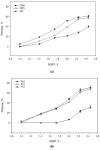Potential Unlocking of Biological Activity of Caffeic Acid by Incorporation into Hydrophilic Gels
- PMID: 39727552
- PMCID: PMC11675749
- DOI: 10.3390/gels10120794
Potential Unlocking of Biological Activity of Caffeic Acid by Incorporation into Hydrophilic Gels
Abstract
Caffeic acid, a phenolic compound with antioxidant and antimicrobial properties, shows promise in the dermatological field. The research aimed to incorporate caffeic acid into hydrophilic gels based on poloxamer 407, carbomer 980, and their mixture in order to enhance its biological activity. Different gel formulations were prepared using different concentrations of these polymers to optimize caffeic acid release characteristics. The results showed that increasing the concentration of polymeric materials increased the viscosity and slowed down the release of caffeic acid. The antioxidant and antimicrobial activities of the gels were assessed. The results confirmed the potential of hydrophilic gels as delivery systems for caffeic acid, with formulations showing antimicrobial activity against Gram-positive Staphylococcus aureus bacteria and antifungal activity against Candida albicans fungus. This study provides a perception of the development of new semi-solid caffeic acid-based formulations for therapeutic and cosmetic applications.
Keywords: antimicrobial; caffeic acid; carbomer; hydrogel; poloxamer.
Conflict of interest statement
The authors declare no conflicts of interest.
Figures










Similar articles
-
Nanoparticulate Gels for Cutaneous Administration of Caffeic Acid.Nanomaterials (Basel). 2020 May 18;10(5):961. doi: 10.3390/nano10050961. Nanomaterials (Basel). 2020. PMID: 32443503 Free PMC article.
-
Antimicrobial Activities of Propolis in Poloxamer Based Topical Gels.Pharmaceutics. 2021 Nov 26;13(12):2021. doi: 10.3390/pharmaceutics13122021. Pharmaceutics. 2021. PMID: 34959303 Free PMC article.
-
Thermoresponsive fluconazole gels for topical delivery: rheological and mechanical properties, in vitro drug release and anti-fungal efficacy.Pharm Dev Technol. 2015 Jan;20(1):41-9. doi: 10.3109/10837450.2013.846376. Epub 2013 Oct 25. Pharm Dev Technol. 2015. PMID: 24160864
-
Current Status of Mucoadhesive Gel Systems for Buccal Drug Delivery.Curr Pharm Des. 2021;27(17):2015-2025. doi: 10.2174/1381612824666210316101528. Curr Pharm Des. 2021. PMID: 33726644 Review.
-
Discovery and Development of Caffeic Acid Analogs as Versatile Therapeutic Agents.Pharmaceuticals (Basel). 2024 Oct 20;17(10):1403. doi: 10.3390/ph17101403. Pharmaceuticals (Basel). 2024. PMID: 39459042 Free PMC article. Review.
Cited by
-
Caffeic Acid and Erythromycin: Antibacterial and Synergistic Effects on Staphylococci.Pharmaceuticals (Basel). 2025 Jun 26;18(7):964. doi: 10.3390/ph18070964. Pharmaceuticals (Basel). 2025. PMID: 40732254 Free PMC article.
-
Antimicrobial, antibiofilm and antioxidant activities of bioactive secondary metabolites of marine Scarus ghobban gut-associated Aspergillus niger: In-vitro and in-silico studies.Sci Rep. 2025 Jul 2;15(1):23620. doi: 10.1038/s41598-025-06605-6. Sci Rep. 2025. PMID: 40603413 Free PMC article.
-
Phenolics as Active Ingredients in Skincare Products: A Myth or Reality?Molecules. 2025 Mar 23;30(7):1423. doi: 10.3390/molecules30071423. Molecules. 2025. PMID: 40286007 Free PMC article.
References
-
- Ravetti S., Clemente C., Brignone S., Hergert L., Allemandi D., Palma S. Ascorbic Acid in Skin Health. Cosmetics. 2019;6:58. doi: 10.3390/cosmetics6040058. - DOI
-
- Kabała-Dzik A., Rzepecka-Stojko A., Kubina R., Jastrzębska-Stojko Ż., Stojko R., Wojtyczka R.D., Stojko J. Comparison of Two Components of Propolis: Caffeic Acid (CA) and Caffeic Acid Phenethyl Ester (CAPE) Induce Apoptosis and Cell Cycle Arrest of Breast Cancer Cells MDA-MB-231. Molecules. 2017;22:1554. doi: 10.3390/molecules22091554. - DOI - PMC - PubMed
LinkOut - more resources
Full Text Sources

